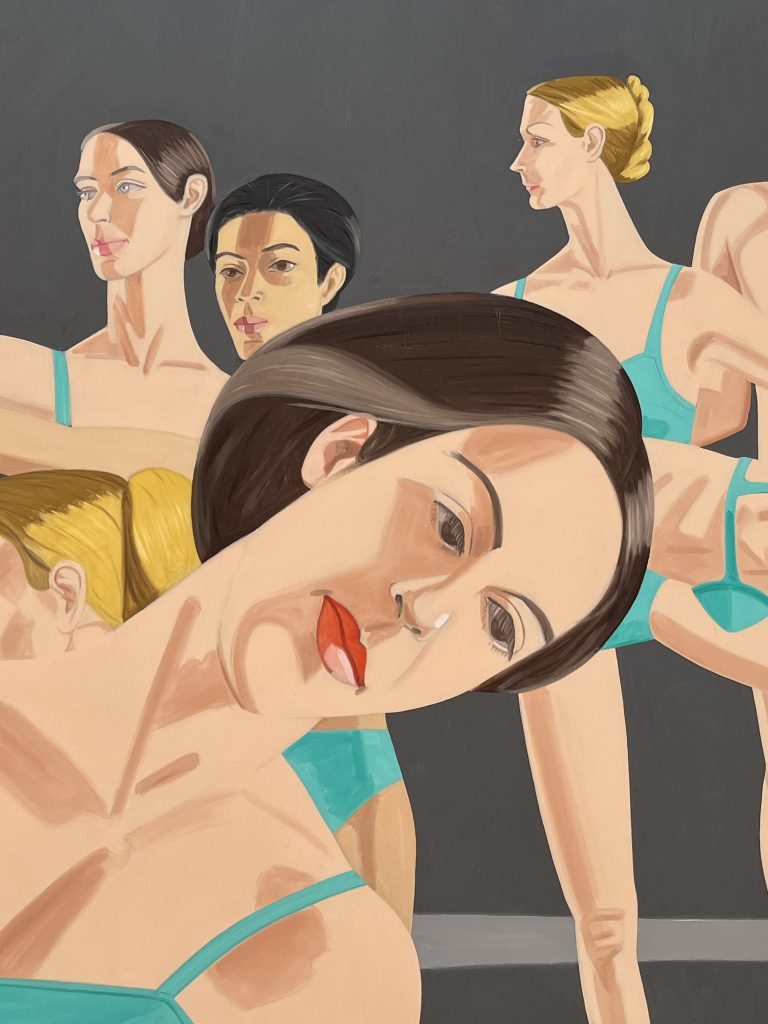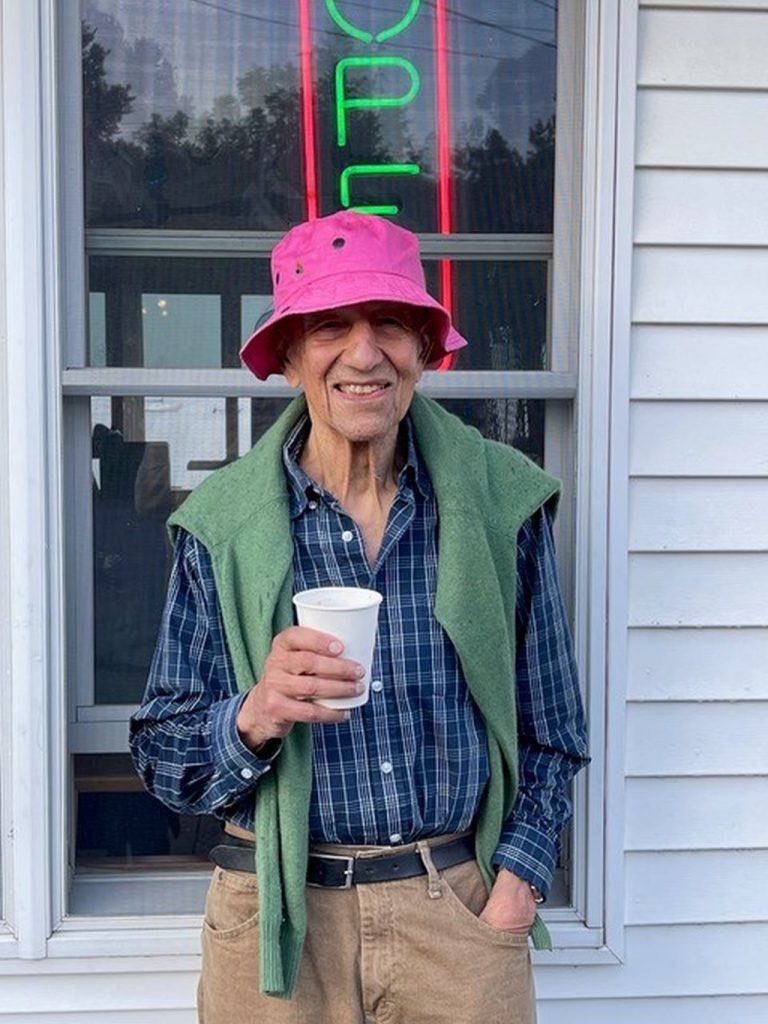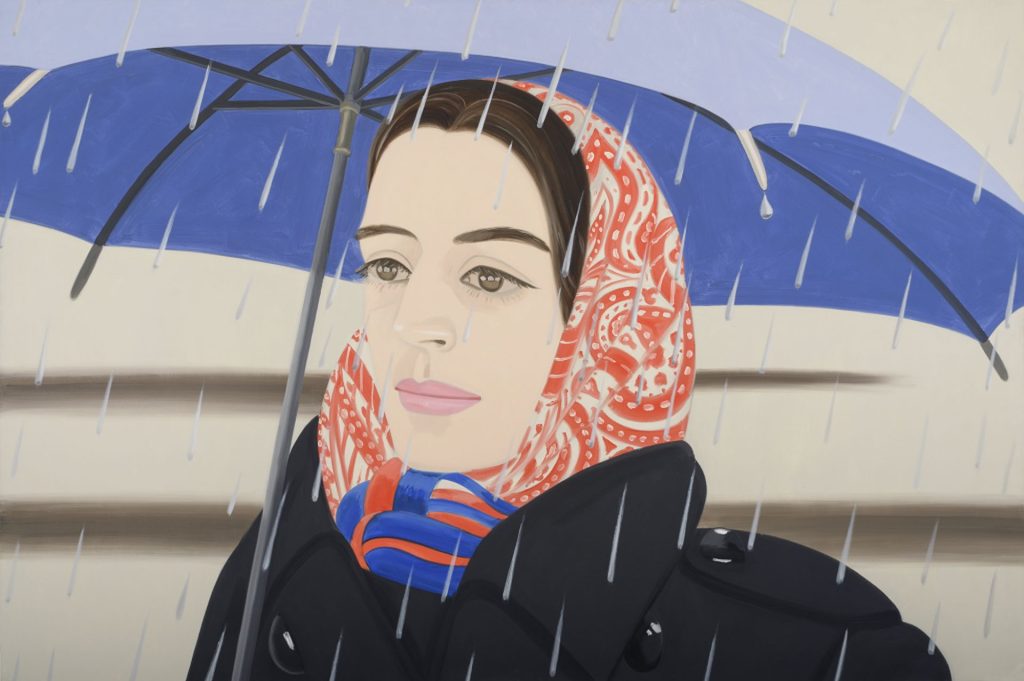
© Alex Katz, Blue Umbrella 2, 1972, © Pictoright Amsterdam 2023. olieverf op linnen/oil on linen 243,8 x 365 cm, Private Collection, New York
Alex Katz: 'The only person you don't want to bore is yourself'
Gerda J. van Ham
The American artist Alex Katz (1927) is a living legend. He still paints every day in his fifth-floor loft in Soho, New York, or from his Maine country house. He needs stairs, construction lamps and large brushes for his enormous canvases. At an advanced age, Katz also works with cardboards (preliminary studies). Along the enlarged contours he blows pigments or charcoal through holes, a proven technique from the Renaissance, which Michelangelo also used to his advantage.
Alex Katz is an international celebrity, but virtually unknown in the Netherlands. At first glance it seems that Katz only paints well-groomed people and sunny landscapes with flowers. Or is there more hidden behind the smooth brushstrokes? His mother urged him at an early age never to paint clichés.
The son of Russian emigrants, Katz grew up in the Queens neighborhood, where his Jewish mother Sima would become a celebrated actress (pseudonym Ella Marion) in Yiddish theatre. She passed on to him the love of poetry and the visual arts. From 1946 he attended the Cooper Union Art School in Manhattan and received a special scholarship to the Skowhegen School in Maine where, like the Impressionists, he was inspired by painting in the open air (en plein air). This revelation gave him his ultimate destiny to become a painter. After college, he was immediately drawn into a circle of artists, poets, photographers, choreographers and art critics known as the second-generation New York School. His deep friendships with artists and their joint projects are still an important breeding ground for his work. At the same time, he also witnessed the rise of American Abstract Expressionism, the action paintings of Jackson Pollock, the unrestrained paint eruptions of Willem de Kooning and the rise of Pop Art icon Andy Warhol. Connoisseurs and critics thought that his smooth, figurative work went against the 'Zeitgeist', but he himself had no desire to interpret his art in a social context.
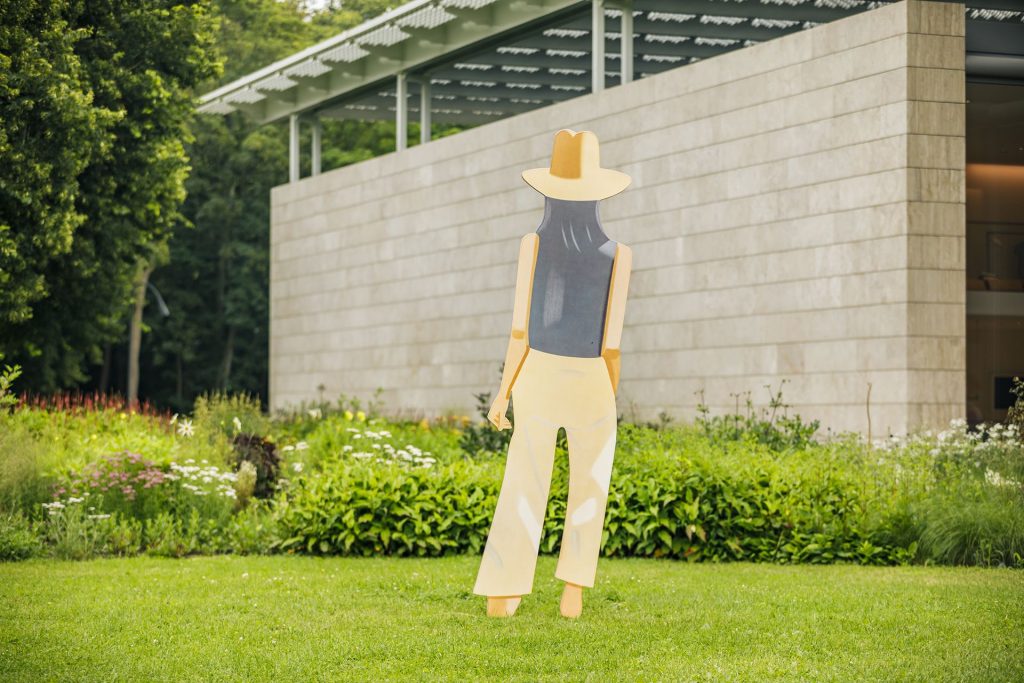
© Alex Katz,Park Avenue Departure, 2019 c/o Pictoright Amsterdam 2023, Porselein-emaille op staal/porcelain enamel on steel, 244x79x4 cm, Collection museum Voorlinden, foto/photo Bram Vreugdenhil
Katz likes to refer to the huge billboards along the highways with their cheerful advertising messages. According to Katz, it is a challenge to also give the painted surface a sensory experience. Light plays a crucial role in this. In 1962 he spent a year painting the incoming light from his bedroom window in New York and Maine. Light is his specialty. The subtlety in all color nuances of paint provides depth on the flat surface. Katz famously said, "I can't think of anything more exciting than the surface of things."
In the garden of Piet Oudolf, the green oasis around Museum Voorlinden, suddenly a slender appearance with a sun hat (cut-out) stands between the lush crops. It is Ada Katz, the artist's wife and muse. He painted her so often (at least a thousand times) that the Jewish Museum in New York (2006) organized the exhibition 'Katz paints Ada'. At that exhibition, Marlene Dumas first saw the qualities of Katz's artistry. It moved her, while she was usually involved in a fierce disagreement with her partner Jan Andriesse, who admired Katz's work. So much so that he bought a small painting by Katz called 'Erik' from an inheritance. For a long time, Marlene saw Katz as an "unwelcome" intruder in the home. She only realized after their discussions what happens in a 'good and successful' Katz painting: 'The painted energy is expansive'. With the further explanation that a successful artwork by Katz gives oxygen and does not have a suffocating effect. After long hesitations, Dumas gave in. And she may not be alone.
While Ada Katz walks in the garden as a cropped silhouette in summer trousers, sun hat and bare arms, in a painting in the museum she hides under a ravishing black hat and black sunglasses against a lemon yellow background. Katz unmistakably gave her the allure of style icon Jacky Kennedy. Only on closer inspection do the accents stand out, a colored stripe above her eye, below the mirrored lenses and below the seductive mouth. Katz painted her delicately scalloped collar paired with a fragment of her pearl necklace. In another room we see her in Blue Umbrella 2 (1972) with a patterned silk scarf around her head and a blue umbrella and black coat. The raindrops fall rhythmically. Finally we catch her face, although the demure look skims past the viewer. Lights dance in her eyes. Her appearance is captivating, intriguing even, but not coquettish. Breathtaking how Katz manages to evoke her time and time again in various images and techniques.
Ada Katz, daughter of Italian emigrants, once a promising biologist and mother of son Vincent, will forever be etched in the retina. Unfortunately, due to her fragile health, she no longer appears publicly at his side.
For Katz, a subway ride in New York is a sensory spectacle. He observes the people around him, in their extravagant clothing, wonderful hairstyles and the expressive or dismissive expressions on their faces. He looks at it as if it were a performance or a theatrical performance. As if they were dancers with flowing or abrupt movements. Katz befriended the choreographer Paul Taylor a long time ago and studied his conceptual dance, which lacks expression, form and content, while at the same time being based on a high degree of technique and intelligence. He also recognized himself in this conceptual working method. Katz designed sets and costumes for countless productions by Paul Taylor for decades. It taught him to think in terms of scale, gestures and interpersonal relationships. Despite his daring and stylized dance concepts, Katz noticed that Paul Taylor was never out to please the audience. That was possibly the most important lesson in his life, while his critics like to accuse him of fleeting elegance. Katz does not paint persons with a clear identity, as is currently very popular. No, he actually magnifies the social image, as a successful imitation of successful people who can also cross your path every day on their way to work. Men in checkered or striped suits, with combed hair that fell straight. Women in elegant suits. A world without tattoos or piercings, without disability and discomfort.
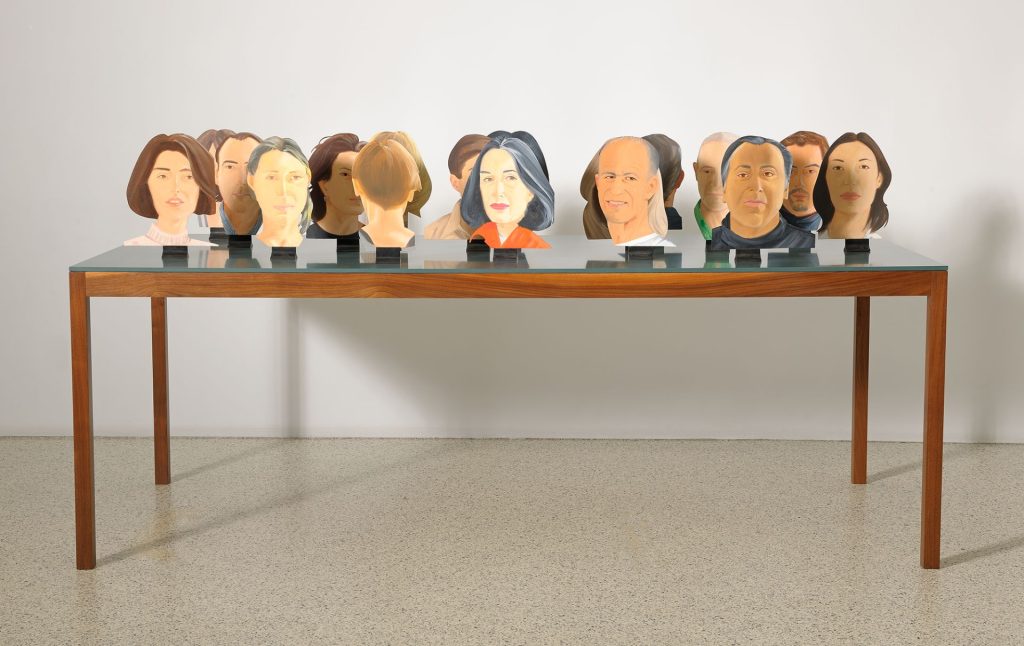
© Alex Katz: Green Table, 1996,mc/o Pictoright Amsterdam, olieverf op aluminium/oil on aluminum, diverse afmetingen/variable dimensions, Private collection, London
Katz loves the outdoors, he bought a cottage on the coast of Maine in the 1950s where he still spends his long summers. He found a stream that represents the same symbolism for him as Claude Monet's pond full of water lilies in Giverny. The light effects on the water, the cloudy reflection of trees and leaves have led to a series of works under the name: Black Brook. With coarse brushstrokes he evokes endless reflections, like close-up images from a melancholic film. He also likes to paint flowers and trees through which the wind plays and light and shadow are filtered. Katz: 'Eternity exists in minutes of absolute awareness'.
On a table in Museum Voorlinden are the painted silhouettes (cut-outs) of friends and family of Alex Katz. His wife Ada is immediately recognizable with her black / gray hair and red blouse, next to her their son Vincent. They are the silent witnesses of a still growing oeuvre. They know Alex Katz personally, admire him and have seen him develop into a sensitive artist of light and shadow. With Alex Katz, beauty and transience go hand in hand.
Translator: Benjamin Binstock
Alex Katz, until 1 October 2023, Museum Voorlinden, www.museumvoorlinden.nl

